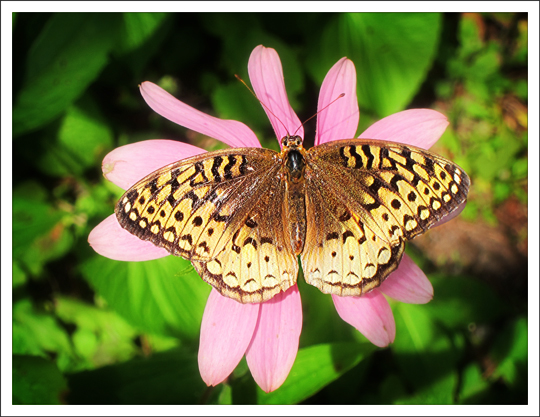Butterflies of the Adirondack Mountains:
Great Spangled Fritillary
(Speyeria cybele)
 Butterflies of the Adirondacks: Great Spangled Fritillary in the Paul Smiths VIC Butterfly House (25 August 2012)
Butterflies of the Adirondacks: Great Spangled Fritillary in the Paul Smiths VIC Butterfly House (25 August 2012)
| This page is no longer being updated. For an updated version of this material, see: Great Spangled Fritillary (Speyeria cybele). |
The Great Spangled Fritillary (Speyeria cybele) is a butterfly that may be seen in the Adirondack Mountains of upstate New York in mid to late summer. Fritillaries belong to the family of brush-footed butterflies. The name "fritillary" is derived from the Latin word for "dice box," which is suggested by the checkered pattern of orange and black on the upper surface of the wings. [1] The name "spangled" refers to the silvery "spangles" on the undersurface. [2] The name "Cybele" is a reference to Cybele, the Anatolian earth goddess.[3] [4]
From above, the male is tan to orange with black scales on its forewing veins. The female Great Spangled is somewhat larger and darker than the male, [5] usually a yellow brown, darker at the base of the wings. [6] From below, the hind wing has a wide pale submarginal band with large silver spots.[7] In contrast to some other fritillaries, this species lacks a black spot near the base of the fore wing cell. [8]
Male Great Spangled Fritillaries appear earlier than females to initiate the flight season. [9] Males patrol throughout the day, seeking females. [10] Female Great Spangled butterflies lay their eggs in late summer on or near their violet hosts. [11] The newly-hatched caterpillars overwinter until spring[12] and then crawl to nearby host plants. [13] Host plants include various violet species.[14] [15] [16] Adults consume the nectar from many species of flowers including milkweed, dogbane, vetch, red clover, and purple coneflower. [17]
The habitat of the Great Spangled Fritillary includes forests, woodlands, swamps, marshes, bogs, moist meadows and fields. [18] [19] This butterfly reportedly prefers moist areas in rich soil. [20] The range of the Great Spangled butterfly includes southern Canada and the northern US (including New York State), south to northern Georgia and west to California and Oregon. [21] [22] It is said to be one of the most conspicuous and common butterflies over meadows and roadsides in parts of the east. [23]
The Great Spangled Fritillary butterfly was seen in early July 2012 in the Adirondack Mountains south west of Paul Smiths. [24] We generally see them in the Paul Smiths VIC Butterfly House mid to late summer. [25]
References
- Susan Grimm Hanley. Interpretive Naturalist, Paul Smith's College Native Species Butterfly House. Species Logbooks.
- Butterflies and Moths of North American. Species Profiles. Sighting records: 8/18/12, 8/25/12, 8/26/12
- Government of Canada. Canadian Biodiversity Information Facility. SpeciesBank.
- Massachusetts Butterfly Club. Massachusetts Butterfly Species List.
- ENature. Field Guides.
- Iowa State University. Department of Entomology. BugGuide.
- National Audubon Society. Field Guide to Butterflies (New York: Alfred A. Knopf, 1981), pp. 545-546.
- Jim P. Brock and Kenn Kaufman. Kaufman Field Guide to Butterflies of North America (Houghton Mifflin, 2003), pp.158-159.
- Paul A. Opler. A Field Guide to Eastern Butterflies (The Peterson Field Guide Series, Houghton Mifflin Company, 1992,1998), pp. 82-83, 257-258.
- Jeffrey Glassberg. Butterflies of North America (Michael Friedman Publishing, 2002), pp. 126-127.
- James A. Scott. The Butterflies of North America. A Natural History and Field Guide (Stanford University Press, 1986), pp. 325-326.
- Donald and Lillian Stokes. Stokes Butterfly Book. The Complete Guide to Butterfly Gardening, Identification, and Behavior (Little, Brown and Company, 1991), pp. 76-77.
- Jeffrey Glassberg. Butterflies through Binoculars. The East. A Field Guide to the Butterflies of Eastern North America (Oxford University Press, 1999), pp. 103-104, Plate 28.
- Paul A. Opler and George O. Krizek. Butterflies East of the Great Plains: An Illustrated Natural History (The Johns Hopkins University Press, 1984), pp. 132-133, Plate 21.
- Rick Cech and Guy Tudor. Butterflies of the East Coast. An Observer's Guide (Princeton University Press, 2005), p. 162-163.
- David Carter. Butterflies and Moths (Dorling Kindersley, Inc., 1992), p. 131.
